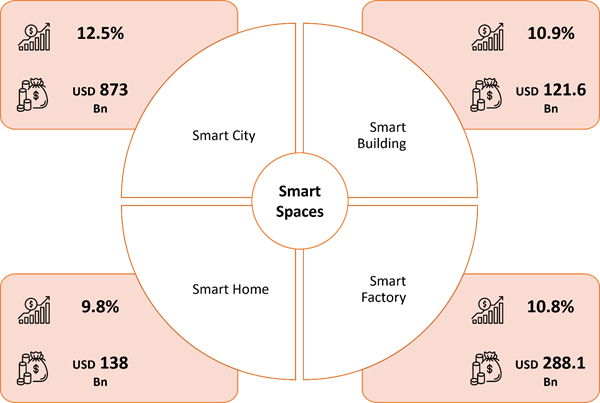CXOs Strive to Invest in Smart Spaces to Gain First Mover Advantage
Smart environments and cutting-edge workplace technologies are crucial to an organization’s strong productivity. These technologies are altering the way CXOs conduct their businesses as well as how employees engage at their workplace. One of these technologies is smart space technology. It plays a significant role in shaping how people, processes, and data are used within the current architectural framework of an enterprise.
Smart spaces are physical areas with networked sensors installed to provide managers with detailed information on the state and utility of such spaces. The potential benefits of smart spaces include risk mitigation, a smarter experience for work and play, cost savings, and environmental benefits.
Smart space technology was developed to optimize commercial spaces, conserve resources, and reduce consumption, cost, and carbon footprint in response to the rising demand for lower energy prices. To address the increasing global energy needs, enterprises are building self-sustaining structures where factories, office buildings, and even entire cities would have “smart environments” with wireless sensors and advanced technology. This helped decrease resource consumption, increase productivity, and improve health, security, and safety. These attractive benefits are encouraging more enterprises to invest in smart spaces.
How integrating smart space technology into existing systems can promote efficiency and improve ROI?
Companies are under pressure to design human-centric workspaces and ensure energy-efficient and sustainable operations while reducing total costs and boosting ROI. Given the scenario, businesses are now seeking solutions that allow them to integrate smart space technology into their existing systems. The following factors are crucial to ensure the integration enables seamless operations and improved ROI:
- Automation: Smart space technology has the potential to automate various functions, such as lighting, temperature, and energy management, resulting in cost savings and increased efficiency. Smart space automation can also reduce human error and increase data collection accuracy.
- Data analysis: Smart spaces can collect data from a variety of systems, including HVAC, lighting, security, and access control, which can then be analyzed to find patterns and trends. This information can be utilized to optimize resource utilization and improve the overall performance of the space.
- Energy management: By automatically adjusting lighting, temperature, and HVAC controls based on occupancy and consumption patterns, smart spaces can optimize energy usage. This can result in significant energy savings and a positive ROI. In Oct 2021, the U.S. Department of Energy (DOE) announced USD 61 million for 10 pilot projects that will use cutting-edge technology to convert thousands of commercial and residential buildings into modern, energy-efficient structures.
- Occupancy and space management: Smart spaces can utilize sensors and analytics to collect data on occupancy and usage patterns. The insights gained can help optimize space use and increase overall building efficiency.
- Predictive maintenance: The smart space automation solution, as a part of smart space technology, allows integration and connection of all systems, including smart devices. Smart spaces can, thus, use sensor data to detect potential problems before they become serious issues, thereby reducing downtime and maintenance costs.
- Employee engagement: Smart workplaces can leverage technology to enhance the overall employee experience, such as by giving real-time information or automating specific duties. This can lead to greater productivity, employee happiness, and retention, all of which benefit ROI.
Developing and building smart spaces is a complex process that demands careful planning and a thorough understanding of the organization’s goals, size, needs, and budget. It is a long-term investment with a long-term return on investment.
Market potential for smart spaces
Organizations worldwide are striving to transform their towns, facilities, industries, and business parks into one intelligent campus that delivers higher safety standards and encourages resource efficiency. Smart space technology has the potential to bring this dream to life. Smart space solutions can handle operations independently, thanks to sensors and autonomy powered by AI.
System integrators and service providers have a lot of economic potential in this area. The smart space market will grow at a consistent 8.3% CAGR over ten years, between 2022 and 2032. System integrators will be essential in integrating smart space solutions into the current system architecture. They will focus on data gathering, processing, and managing the platform.
We anticipate seeing cloud-based service offerings for smart space services soon. We believe that the cloud will make it simple to handle the massive amount of data that smart space solutions create, while also meeting the analytics expectations. System integrators will offer Software-as-a-Service (SaaS) versions of smart space solutions in the future using a cloud-based deployment architecture.

Fig.1: Market potential across segments
How can businesses fully utilize smart spaces?
Long-term benefits will accrue to organizations through the integration of smart solutions, particularly in terms of future choices, targeted investments, and an improved user experience. For instance, machine learning will recognize asset behavior patterns and predict what will happen over time inside a facility based on continually acquired data. This gives CXOs the ability to foresee possible issues with infrastructure maintenance, thereby preventing failures and providing users with an enhanced experience.
Simultaneously, user expectations have changed. They want the business environment to be technologically powered with efficient systems for effective collaboration.
Using digital technology, businesses are reimagining their existing physical infrastructure to:
- Enhance user experiences
- Develop a collaborative culture
- Improve resource efficiency and sustainability
- Increase operational effectiveness
LTIMindtee can power industrial 4.0 applications through IoT. Our solutions enable IT-OT convergence by offering ready-to-deploy industrial-grade IoT solutions with device and data management, along with pre-configured industry use cases.
CXOs can leverage the following potential developments to operationalize smart spaces:
- Advanced sensors and analytics: Using advanced sensors and analytics, smart spaces will be able to collect more data and deliver more insights, which can optimize resource utilization and improve the overall space performance
- Machine learning and artificial intelligence: AI and machine learning can analyze data from smart spaces and anticipate future usage patterns, which in turn can increase space efficiency and lower costs
- Edge computing: Edge computing allows data to be processed closer to the source, reducing latency and improving smart space performance
- Robotics and automation: By automating cleaning, maintenance, and security processes, robotics and automation can improve the efficiency of smart spaces
- Integrated smart systems: Smart spaces can be integrated with other smart systems, such as smart cities, smart transportation, and smart energy systems, enabling the development of new applications and services
- NLP (Natural Language Processing): NLP can enable smart environments to interpret and respond to human speech, thereby improving the consumer experience
- Blockchain: Blockchain technology has the potential to improve security and facilitate data sharing in smart spaces by increasing data transparency and accessibility
- 5G networks: As 5G networks become more common, smart spaces will have quicker and more reliable internet connectivity, enabling widespread adoption of new applications such as augmented reality and remote control.
The Next Frontier in Intelligent Environments
Future predictions indicate that smart environments will continue to change daily living in a variety of ways. Smart campuses, smart cities, and smart buildings are all expected to improve visitor and resident experiences, assist businesses in cutting costs and promoting sustainability, and constantly upgrade systems and services through regular data analysis.
Smart spaces can significantly vary in scale, from individual vehicles and buildings to businesses, academic campuses, communities, and entire cities. The challenge lies in transforming these intelligent, human-friendly surroundings into places that provide quantifiable value for each stakeholder group.
More from Namrata Sharma
Introduction Smart meter deployments have rapidly increased worldwide, driven by utility companies'…
Introduction Have you ever wondered how AI could handle your day-to-day tasks differently?We…
Latest Blogs
Core banking platforms like Temenos Transact, FIS® Systematics, Fiserv DNA, Thought Machine,…
We are at a turning point for healthcare. The complexity of healthcare systems, strict regulations,…
Clinical trials evaluate the efficacy and safety of a new drug before it comes into the market.…
Introduction In the upstream oil and gas industry, drilling each well is a high-cost, high-risk…




